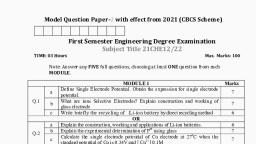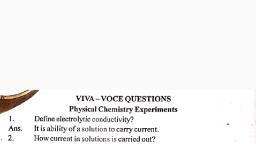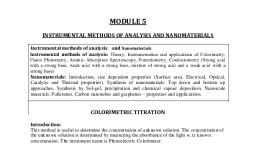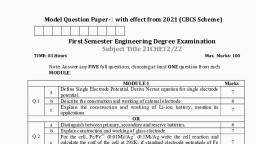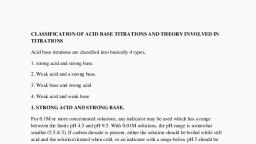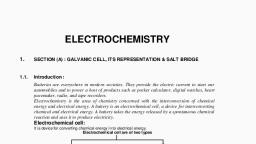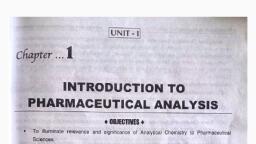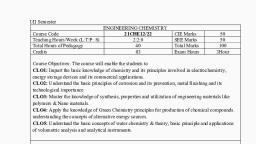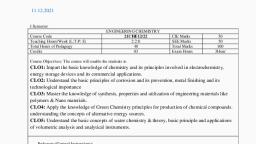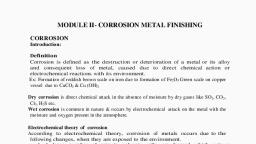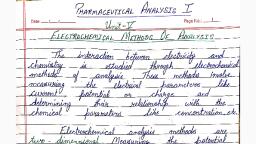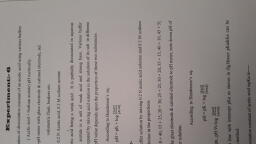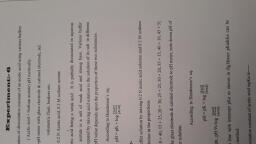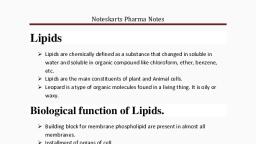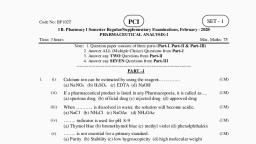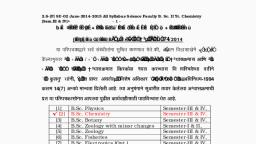Page 1 :
PART- A, 1., , POTENTIOMETRIC ESTIMATION OF IRON, Potentiometric estimation?, Ometric titration is an analytical technique by which the change in concena, n, , 1) What is, Ous, , bf, , redox reactions is, , determined by a change of electrode potentia., 2) What is the, principle of potentiometric titration?, Nerst equation :-, , E=E+2.303 RT/ nF log [M"*], For Redox titration, , E =E+..505 RT, , [oxidised form], [Reduced form], E =E°42.303 RT,Fe, nF -log F e, nF, , log, , Fe, , EFe, Fe, , 3) Give the cell reactions., , Atanode: Fe, , Fe3 + e (oxidation), , At cathode CrO, , +14H +6e, , 2Cr+7H,O (reduction), , Net cell reactions 6Fe?+Cr,O, +14H, , 6Fe+ +2Cr, , +7H,O, , 4) What is FAS?, Ferrous Ammonium Sulphate [(NH,),SO,FeSO,6H,O] (Reducing agent)., the titration., 5) Explain the variation of potential during, decreases, as a result emf increases (Since E, As titration begins [Fes"] increases and [Fe*"], the end point potential is determined by EettECrs0-2 (since [Fe ]=, a [Fe"] /[Fe"].) At, Hence there is a large increase in the potential, 0) E =0.7 V ECe0-21.OV, E =1.7 V., , at the end point., , After the end, , 7), , What, , are, , point there, , is, , gradual, , increase in, , potential since [Cr,0,] increases., , the electrodes in potentiometer?2, , electrode) and platinum electrode (indicator electrode), Calomel electrode (reference, electrode also called, , indicator electrode?, , 8) Why is platinum, the conceniration or ions present in the solution. So the change in, It is susceptible to, the potential developed by platinum electrode and it is indicated, concentration of ions affect, in potential. S0 platinum is called indicator electrode, by the change
Page 2 :
LAB, , VLANUA, , OF, 2. COLORIMETRIC ESTIMATION, nWhat is, , colorimetric, , COPPER, , analysis?, , coloured solution with the, the change, variation in intensity of a given, of va, in, study, study, The, The ation of the given coloured compound in VISIDIe region is called colorimetric, , of, , analysis., , Lambert's law, Beer-Lambert's law., States Beer's Law,, of transmitted light decreases exponentially, Reer's law:- Intensity, , as, , concentration of the, e, , -I.eke, path length is kept constant., decreases exponentially as the path length, Lambert's law:- Intensity of transmitted light, medium 1S constant. I, I.e-kt, arithmetically, when concentration of, when, medium increases arithmetically,, , =, , increases, , Beer-Lambert's law:- Absorbance, medium., length of the absorbing, , or, , optical density, , is, , proportional, , to concentration, , & path, , A a ct, , transmittance, absorbance/ optical density?, Path length is the distance traveled by the light in the medium. It is same as the thickness, , 3)What is the path length,, of the absorbing medium., , Transmittance it is fraction of light transmitted through the medium. It is the ratio of, intensity of transmitted light to the intensity of the incident light., , Absorbance or optical density is the natural logarithm of the reciprocal of transmittance., , A logT log, 4) Why is the path length taken as constant in the estimation of Cu?, Unknown concentration of the solution can be determined by comparing the optical density, of solutions of known concentration. only when the path length is constant. (Beer s law)., , 5) What is the complex formed when NH, solution is added to the CuSO, solution:, , Cuprammonium Sulphate. [Cu(NH,),]SO,. Deep blue in colour., 6) Why are different volumes of solution taken in flasks?, To plot the calibration, graph. If only one volume is taken. only one point is obtainea on ine, graph and so obtained the graph makes it impossible to calculate the Cu" concentranon is, unknown solution which is to be calculated from the graph. Calibration curve 1S the grap, , of absorbance, , against concentration, , of solution., , 7) Why is Ammonia is added? Why is it that the same anmount of ammonia is added, , and the at the same time?, Ammonia is added to get the blue coloured complex. Same amount is added at same time to, nuility the effect of absorbance due to any other colouring matter present in NH, Sluion.
Page 3 :
ENGINEERING CHEMISTRY, , 280, , 8) Why is the Optical Density, Blank solution is taken, , 9) Why 5, , ce, , measured, , reference, as a, , to blank, of NH, added, , Blank solution is one which, concentration in blank is, , 1s similar, , zero. It, , is, , against, , a, , blank, , solution?, , solution., solution?, , to the test solution in all respects, , prepared adding, , 5, , cc, , ofNH,, , other colouring impurity., , to, , eveons, , nullify the effecttheofCu2, any, , 10) Why is absorbance of all solution measured at a fixed wavelength?, The complex favoured shoWS a, , maximum absorbance at a, , D, , values change with wavelength, 11), , Why, , does the, , graph pass through, , particular wavelenotl, , the, , origin?, , Since absorbance of blank solution (copper concentralion is 7ero) is taken as zero, origin is, , taken as the reference point.
Page 4 :
281, , LAB M A N U A L, , 3. CONDUCTOMETRIC ESTIMATION OF ACID, , 1), , State, , ohm's, , XTURES, , law., , in a conductor is dire, directly, states that the current, I (ampere), flowing, Ohm's lawstat, proportional, Ohm's, theportional, electromotive force, E (volt) and inversely proportional to, e, R, o the applied, conductor., the, (ohm) of, , I =E/R, , 2) What is, , conductance?, , The reciprocal, , of resistance, , is called the conductance., , 3) What is conductivity? Write its unit, why is AC power used and not DC, Conductivity is the reciprocal of resistivity. It is the conductance ofa solution of unit molar, concentration when placed between 2 electrOdes, which are unit distance apart, and of unit, area, , of cross section., , cm'or Sm', The unit of Conductivity is 2 m' or Q2', AC power is used to measure the conductivity of the electrolyte. Electrolysis takes place if, DC power is used., , 4) What is the principle of conductometric estimation?, The substitution of ions of one conductivity by ion of another conductivity from which end, point of the titration can be found out graphically., 5) Mention the different types of conductance?, A solution may have the following conductances. Specific conductance. Equivalent, conductance, Molar conductance, , 6) List out the factors on which eonductivity of a solution depends., , Conductivity, , mobility of ions, S1ze of i1ons, , Temperature., 7) Which of the above conductance measured during conductometric titraton:, , The, , specific conductance is measured., 8) What is specific conductance?, c, , COnauclance of a solution placed between two electrodes of I em, , area and kept, , cm apart., , 9) What is, , equivalent conductance?, , is, ne conductance of the solution, which contains, placed between two, electrodes of, , 1=kV, , _kx1000, C, , I, , em, , apart., , 1-gram, , equivalent, , of solute, when
Page 5 :
282, , V=, , volume containing gram, I, , cquivalent, , ot, , solute,, , c, , 10) What is molar conductance, , ENGINEERING CHEMISTRY, Normality of solution., , It is the conductance ofa solution which contains I gram, , molecular weight of a, substar, , when placed between two eleetrodes of I cm apart, m -kV, , 11) What is a ell?, A device, which produces an eleetronotive torce and delivers an electai, , result ofa chemical, , reaction is, , knoWn, , as a, , cell,, , electric current as, the, , 12) What factors determine the conductance of a solution?, Two factors determmng the conductance of a solution ar, , ) Mobility ofions (higher the mobility. higher is the conductance and), , 2) Number of ions (more the nunmber of ions in solution. more is the conductaneel, , 13) What is the principle involhed in conductometric titration?, In conduetometrie titration, there is a sudden change in conductance of solution near the, , end point. Henee the end point is deterined graphically by plotting conductance againct, titre values. The prineiple underlying conductomciric tilration is the replacement ofions of, , a particular conductanee by ions of ditierent conductance during the titration., 14) What are the advantages of conductometric titrations over visual or potentiometric, , titrations?, , 1) The method is accurate in dilute as well as more coneentrated solutions., , 2) It can also be employed with coloured solutions., 3) Very weak acids such as H,B0. phenol. w hieh cannot be titrated potentiometrically in, aqueous solutions. can be titrated conductometrically., , 4) Mixture of acids can be titrated more aceurately., , 15) How is the equivalence point obtained in conductometrie titration'?, During the progress of the titration. change in conductivity oceurs. The conductivity1s, , measured after each addition of a small volume of the titrant. A graplh of conductivity, (on Y-axis) versus volume oftitrant (on N-axis) is plotted when two or more straight lines, , are obtained. The point of intersection of the two straight lines gives the equivalence point, , 16) In the titration of a mixture of acids (HCI and CH,COOH) with a strong base, (NaOH). the conductance first decreases. then rises steadily and finally rises, , steeply. Why?, Upon adding a strong base to a mixture of a strong acid and a weak acid, the conductance, falls due to the replacement of highly mobile H' ions of the strong acid (HC) by less, , mobile Na* ions of the base. The conductance falls till all the H' ions are replaced (1.c., till HCl is neutralised completely). The conductance then rises steadily as the weak actu, is converted into its salt, conductance of the salt is higher than the conductance ot weak, acid. inally, the conductance rises steeply as excess of alkali is introduced, due to highy, mobile OH ions.
Page 6 :
5. DETERMINATION OF, , pKa VALUE OFAWEAK, ACID, , ) What is the difference between a strong acids & weak acids?, Strong acids dissociates completely in aqueous medium., , HCI, , H+C, , H,SO,, , 2H +So, , HNO, H+NO, Weak acids dissociate, , CHCOOH +, , partially, , H,O, , in aqueous solution., , =CHCO0 + H,0, , 2) What is pH?, , pH-logH], It is a measure of strength of acid., 3) What is pKa?, pka = -log, Ka. Where Ka is the dissociation constant of a weak acid., , It is the modern method of, expressing the, , strength, , 4) What is, , &, , the, , relationship, , between, , pH, , of weak acids., , pKa?, , pH pKa+ log salt, acid], Henderson Hasebatch equation., 5) What is the significance of pKa?, -, , It measures, , the, , strength, , 6) Why pH increases, , of a weak acid., , addition of NaOH to a weak acid?, AS NaOH is a, strong base it dissociates completely forming OH' which reacts with H1ons, producing H,O. Thus H' ion concentration decreases. As a result pH increases., , pH, , on, , -log(H'), pH a, , 1/[H], 7) Write the range of, pH., The pH from 0 to < 7, acidic, 7 Neutral,, 8) What reaction takes, place when, , a, , >7 to 14 basic., , base is added to, , a, , weak acid?
Page 7 :
LAB, , MANUAL, , salt, , and, , H,O., , giving, , CH,COONa ++ H,O, , Neutralization, , CHCOONa, , NaOH, CH,COOH, , 9) How, 9), , How, , of, point., point, , end, end, is the, , plotting, , a, , By, , the, , t i t r a t i o n determined?, , o fApH/AV against, nh of, graph, , pka =, , ApH/A, , volume of base used., , pH, , Equivalence, point (V, , ApH, h a l fequivalence, , pH, , AV, , (V12, , V, , NaOH cn, , 10) What, , are, , NaOH(cm), , the determination of pKa?, the electrodes used in, , electrode, calomel electrode assembly)., Combined electrode (glass, , 11), , How do you find, , pka, , from, , graph?2, , and the pH corresponding, By finding the half equivalence point, , 12) Why pH= pKa, , at, , to, , it., , halfequivalence point?, , At halfequivalence point [Saltj= lacid], Therefore,, , Henderson's, , 13) Why pKa, , equation, , reduces to, , pH, , =, , pKa. (since log 1=0), , is not defined for strong acids, , Strong acids undergoes complete, , dissociation, , in, , aqueous medium., , 14) Give the pKa of formic acid and acetic acid., pKa of formic acid is 3.75 and acetic acid is 4.76

